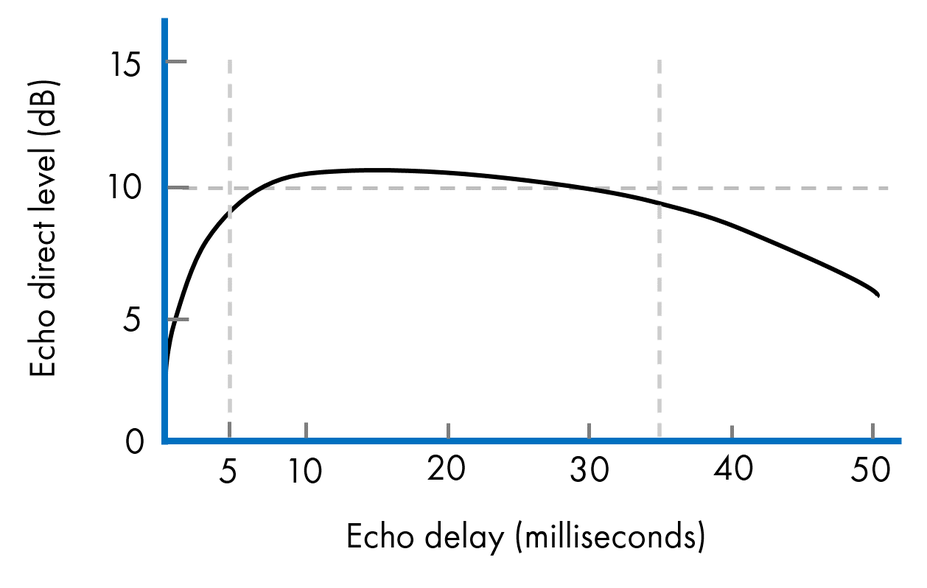Early 50’s audio researchers made key findings related to the human perception of sound, reflections and echoes. Their fundamental work is not only interesting, but can be used to our advantage in audio mixing and live sound applications. Let’s go through details and further insights here.
To start with, our hearing mechanism integrates sound intensities over short intervals and acts somewhat like a ballistic measuring instrument. In simpler terms, in an auditory situation, the ear and brain have the remarkable ability to gather all reflections arriving within about 35-50 milliseconds (ms) after the direct sound and combine, or integrate, them to give the impression that all this sound is coming from the original source, even though reflections coming from other directions are involved.
The Precedence Effect
The Precedence effect was described and named in 1949 by Hans Wallach1 and fellow researchers. They showed that when two identical sounds are occurring in close succession they will be heard as a single sound event. In their experiments, this fusion occurred when the delay between the two sounds was between 1 and 5 ms for clicks, and up to 50 ms for more complex sounds. In fact, this range is signal dependent, and for speech the Precedence effect disappears for delays beyond 50 ms, and for music the effect can disappear for delays of even 100 ms. Basically, when the delay is sufficiently long, the second sound is heard as an echo.
They also showed that when successive sounds coming from sources placed at different locations were heard as fused, the apparent location of the perceived sound was dominated by the location of the sound that reached the ears first (therefore the name ‘precedence’). The second and later-arriving sounds had minimal effect on the perceived location of the fused sound. This phenomenon plays a key role in our hearing abilities in enclosed rooms, as it remains possible to determine the direction of a sound source (e.g. the direction of a loudspeaker or instrument) even in the presence of various wall reflections.
The Haas Effect
The Haas effect derives from a 1951 paper by Helmut Haas2, where he examined how the perception of speech is affected in the presence of a single, coherent sound reflection. He confirmed Wallach’s work showing that we localize sound sources in the direction of the first arriving sound despite the presence of a single reflection coming from a different direction.
He further demonstrated that a reflection arriving later than 1 ms after the direct sound increases the perceived level and width of the sound source. Additionally, a single reflection arriving within 5 to 35 ms can be up to 10 dB louder than the direct sound without being perceived as a secondary auditory event (echo).
To summarize, the Haas effect is a special appearance of the Precedence effect where the range of delays between a direct sound and a reflection leading to a single perceived sound event is reduced below 35 ms.

Haas Effect in Audio Mixing
To take advantage of the Haas effect while mixing, you probably have noticed that very short, delayed sounds can create a sense of spaciousness, while longer delayed sounds provide distinct repeats and a greater sense of directionality.
In general, in an audio mix, the sense of directionality is provided by panning sound sources and it is achieved by varying the volume going into each channel (typically the main left and right channels of a stereo mix). Using delays, however, controls the timing of each channel. As humans, we rely on both intensity and timing to perceive sound, so capitalizing on the Haas effect can yield some interesting results.
To create a wider stereo image, which lends itself to a broader mix with more depth, one method is to duplicate a mono track and pan each of them hard left and hard right. Then, by adding a short delay to one of the tracks, the result will be that the two mono tracks played together will sound wider than they really are. The precise delay time is very dependent on the actual content of the track, so some experimenting is necessary to yield a good result. To do so, QSC TouchMix mixers feature a 100 ms delay on each input channel, as well as another 100 ms delay on the output processing section. Plenty to find the sweet spot and enhance your mix.
As a general guideline, a delay of around 5 ms on one track will effectively enhance directionality and generate an ‘out-of-phase’ type sound. As an example, by delaying the left-panned channel by 5 ms, the sound will appear more intense in the right-panned channel. Beyond 10 ms of delay, the two mono tracks will sound wider, rather than more or less intense in one channel. In all cases, the basic rule is to keep the delay time below our ears’ echo threshold (approximately 35 to 40 ms), so that no distinct repeats, or echoes, become audible.
Haas Effect in Sound Reinforcement
Haas’ findings can be applied to sound reinforcement and PA systems as well. The signal sent to loudspeakers placed at distant locations from a stage may be delayed electronically by an amount equal to the time sound takes to travel through the air from the stage to the distant location, plus about 10 to 20 ms and played at a level up to 10 dB louder than the sound emanating from the stage.
Doing so, the first sound arrival from the main PA loudspeakers still determines the perceived localization, whereas the slightly later incoming sounds from delayed loudspeakers simply increase the perceived sound level without negatively affecting localization. In this configuration, the audience will localize all sounds as coming from the main stage, benefiting also from higher sound level.
Conveniently, QSC K.2 Series™ active loudspeakers and KS Series active subwoofers let you set their on-board delay in either meters, feet or milliseconds. The ranges are from 0 to 100 milliseconds, equivalent to 0 to 34 meters, or 0 to 113 feet. Remember that the reference speed of sound is 344 m/sec, or 1128 feet/sec (1 sec equals 1000 milliseconds). Practically, the easiest way to set each delayed loudspeaker is to measure the actual distance between the main loudspeakers and your delayed loudspeaker(s) and enter the adequate value in each loudspeaker requiring a delay.
Conclusion
Being more familiar with the psychoacoustic phenomena of the Precedence and Haas effects will let you experiment with possibly new mixing techniques. In short, to create a wider, deeper stereo image, duplicate a mono track and pan one channel hard left and the other hard right. Delay one channel somewhere between 10 to 35 ms, and you will create a mix with an enhanced stereo image. In PA system applications, adding 10 to 20 ms to correctly delayed loudspeakers, at a level up to 10 dB compared to the front-of-house level, and the audience will localize all sounds as emanating from the main stage, benefiting also from higher sound level. Happy mixing!
References:
(1) Hans Wallach (November 28, 1904 – February 5, 1998) was a German-American experimental psychologist whose research focused on perception and learning.
(2) Haas, Helmut, The influence of a single echo on the audibility of speech, J. Audio Eng. Soc., Vol. 20, Issue 2, pp. 146-159, March 1972 (English translation by Dr. Ingr. K.P.R. Ehrenberg of Haas’ original German paper published in Acustica 1, pp. 49-58, 1951).
(3) Image from the Master Handbook of Acoustics, F. Alton Everest, Fourth Edition, McGraw-Hill, page 75, Fig 3-19.
Christophe Anet
Latest posts by Christophe Anet (see all)
- History, Development and Applications of Column Loudspeakers - May 30, 2025
- Why is Dynamic Range so important? - May 30, 2023
- Differences between Flown and Floor-Mounted Subwoofer Deployments - May 2, 2023
